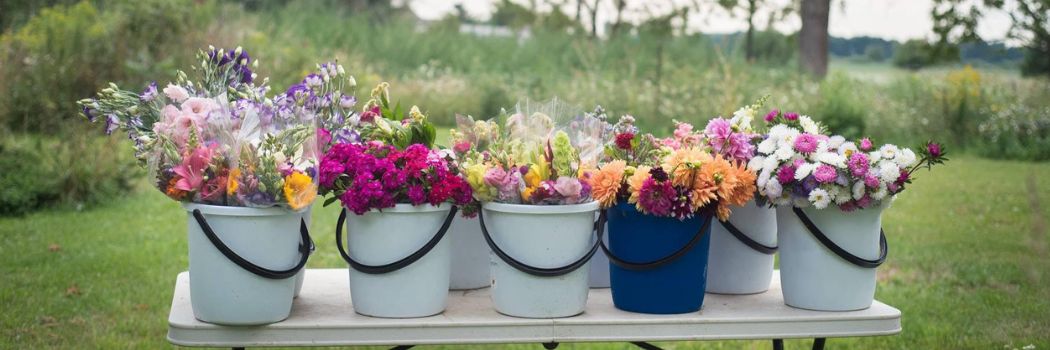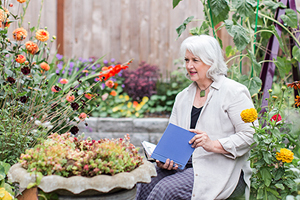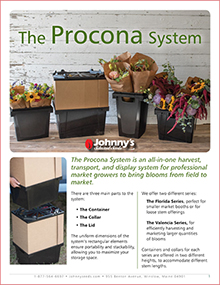- 3 Easy, Reliable, Productive Cut Flowers: Sunflowers, Zinnias & Rudbeckia
- 5 Factors That Determine Vase Life of Cut Flowers
- 2019 American Flowers Week: Combining the Art of Floral Design & Couture
- Celebrate the 7th American Flowers Week | Johnny's 2021 Botanical Couture
- Celebrating the 8th American Flowers Week | Johnny's 2022 Botanical Couture
- Collective Selling Models for Flower Farmers: Flower Hubs That Work
- 5 Cool Flowers to Plant Now | Lisa Mason Ziegler's Secrets for Growing Hardy, Cool-Season Annuals
- Cut-Flower Harvesting & Post-Harvest Care | Best Practices from Pros in the Slow Flower Community
- Cut-Flower Kit | Guide for Market Growers (PDF)
- Easy Cut-Flower Garden Map | For Growers New to Flowers (PDF)
- Easy Cut-Flower Garden Planner | For Growers New to Flowers (PDF)
- From Color to Climate: 5 Floricultural Trends Subtle & Seismic
- Flower Culture by Crop | Comparison Chart | Days to Germination, Weeks to Transplant, Days to Harvest (PDF)
- Flower Farmers' Favorite Fillers & Foliage | Recommendations from 3 Farmer-Florists
- Getting Started in Cut-Flowers | Top 15 Cuts
- Heat & Drought: How Flower Farmers Are Adapting to Changing & Challenging Climatic Conditions
- Introduction to Overwintering Flowers | Guide to Overwintering Flowers
- An Introduction to Producer Marketing Cooperatives | M Lund & Associates
- How Day Length Affects Cut-Flower Production
- Growing Flowers in Hoophouses & High Tunnels: Cool-Weather & Hot-Weather Options
- Starting a U-Pick Flower Farm, From A-to-Z
- Roadside Flower Stand Basics: Success Tips for On-Farm Retail
- Year-Round Flower Production Strategy
- Overwinter Flower Trials | Multiyear Results for 30+ Crops | Johnny's Selected Seeds | XLSX
- Seeding Date Calculator | Johnny's Recommended Flowers for Overwintering | XLSX
- Just Add Flowers | An Introduction to Companion Planting for Vegetable & Herb Gardeners
- Pricing & Profitability for Flower-Farmers | Pointers from a Diversity of Pros
- Sustainable Farming Methods | A Survey of Flower Farmers' Best Practices
- Slow Flowers Palette & Petal Crushes | Evolving Colors & Shape-Shifts in Floral Industry Trends
- Johnny's and Slow Flowers | Johnny's Selected Seeds
- Slow Flowers | Celebrating Fifth-Season Regional Design Elements
- Slow Flowers Floral Forecast | A Summary of Industry Insights & Trends
- Building a Better Market Bouquet: Tips, Techniques & Recipes for Flower Farmers
- Slow Flowers | Tips for Staging On-Farm Floral Workshops | Johnny's Selected Seeds
- Wedding Wisdom 101 | 10 Beginner Tips for Entering the Wedding Floral Landscape
- Succession-Planting Flowers | Scheduling & Planning, Sowing Frequency, Recordkeeping & Recommendations
- Succession-Planting Interval Chart for Flowers
- Sustainable Floral Design | Techniques & Mechanics for Foam-Free Floristry | Tobey Nelson & Debra Prinzing
- Video: Mason Jar Bouquet Tutorial
- Video: How to Build a Bouquet
- Video: Tobey Nelson | Sustainable Floral Design | Slow Flowers Summit
- Video: Economic Considerations in Overwintering Cut Flowers | Johnny's Selected Seeds
- Top 10 Cut-Flower Varieties for Direct Seeding
- Video: Floating Row Cover | Baby "Cool Flower" Protection from Whipping Winter Winds
- Video: The Procona System for All-in-one Flower Harvest, Transport & Display
- Johnny's Overwinter Flowers Tunnel: Trellising, Supports, Ground Cover & Spacing
- Video: Irrigation Considerations for the Overwinter Flowers Tunnel | Johnny's Selected Seeds
- Video: Johnny's Overwinter Flowers Trial Recap
- Video: Producer Cooperatives for Small-Scale Farmers | Johnny's Webinar Series
- Climate Adaptation for Vegetable & Flower Farmers | Johnny's Educational Webinar Resources
- Chrysal Classic Professional 2 Transport & Display (Holding) Solution | SDS
- Choosing Flower Crops to Overwinter | Guide to Overwintering Flowers
- Chrysal Clear Universal Flower Conditioner | SDS
- U-Pick Power for Your Flower Farm | Johnny's Webinar Series
- Chrysal Professional 3 Vase Solution Powder | SDS
- Bloom to Boom: Flower Farm Profitability
- Webinar Slide Deck | U-Pick Power for Your Flower Farm | PDF
- Chrysal Professional 1 Hydration Solution | SDS
- Edible Flowers List: Top 20 Favorites from the Slow Flowers Community
- U-Pick Power for Your Flower Farm | Johnny's Webinar Series
- Floral Standards for Flower Farm Collectives and Cooperatives
- Chrysal Professional 2 Transport & Display T-Bag | SDS
- Eat Your Flowers: Serve Up That Wow Factor With Edible Flowers
- Chrysal CVBN Flower Conditioner | SDS
- When to Start Seeds for Overwintered Flowers | Guide to Overwintering Flowers
- Introduction to Forcing Flower Bulbs in Soil | Guide to Forcing Flower Bulbs
- Webinar Slide Deck | Flower Growing in Southern States | PDF
- Forcing Tulip Bulbs | Guide to Forcing Flower Bulbs
- 10 Tips for Building a Profitable Cut-Flower Business
- Chrysal Clear Bulb T-Bag | Cut-Flower Conditioner | SDS
- Video: Flower Growing in Southern States | Johnny's Webinar Series
- Flower Growing in Southern States | Johnny's Educational Webinar Series
- Chrysal Clear Bulb Flower Conditioner | SDS
- Choosing Tulip Varieties for Forcing | Guide to Forcing Flower Bulbs
- Snapdragon Groups Explained
- Flowering in the South: Profiles of 5 flower farmers who cope with temperature, humidity, pest & weed pressure
- Webinar Slide Deck | New-for-2023 Flowers & Floral Supplies | PDF
Cut-Flower Harvesting & Post-Harvest Care
Best Practices & Wisdom from the Slow Flower Community
By Debra Prinzing, Slow Flowers Society
The theme of this article is inspired by a hashtag that's trending on social media: #grownnotflown. I am pretty sure my flower-farming friends in the UK deserve credit for coining this phrase a few years back to differentiate their crops from imported ones, and nowadays North American cut-flower growers are adopting the #grownnotflown hashtag.
Trends aside, we know that fresh, local, and seasonal cut flowers are superior to those that travel from afar to reach your customers and your market. What are the best practices for harvesting and caring for flowers, herbs, and foliages before they leave your fields and workshops, to safeguard their quality?
I surveyed five specialty cut-flower growers, all members of Slow Flowers, to glean from their experiences and insights. What you'll read here is collective and cumulative wisdom that adds up to three-quarters of a century of farming and selling flowers.
The following advice comes from Charles Little of Eugene, Oregon-based Charles Little & Co; Laura Mewbourn of Feast & Flora Farm, based in Meggett, South Carolina; Janis Harris of Harris Flower Farm in St Thomas, Ontario, Canada; Ralph Thurston and Jeriann Sabin of Deadhead Cut Flowers in Blackfoot, Idaho; and Melissa Garcia Parry of Howl & Whistle Flower Farm, also in Eugene, Oregon.
Without hesitation, flower farmers cite a publication from the Association of Specialty Cut Flower Growers as their go-to reference: Postharvest Handling of Cut Flowers and Greens. Subtitled A Practical Guide for Commercial Growers, Wholesalers, and Retailers, the book is "a must when I have a new crop I'm harvesting," says Laura Mewbourn.
As a farmer–florist, Laura's take on the grown-not-flown mantra is twofold: "The biggest selling points for my flowers are that I am growing things that don't ship well or can't be purchased from the wholesaler at all, and that I deliver all of my product in considerably better condition than most of what has been shipped dry."
Janis Harris echoes these sentiments on the value of locally-sourced blooms: "We make sure that we educate our customers and sell them the right flower for their needs," she says. "A bride needs her bouquet to look perfect for a few hours, so we are able to use more unique stems that have shorter vase life. And a market bouquet has to be filled with longer-lasting flowers, so they will bloom for the friend in the hospital or the grandma living in a nursing home."
What to Grow
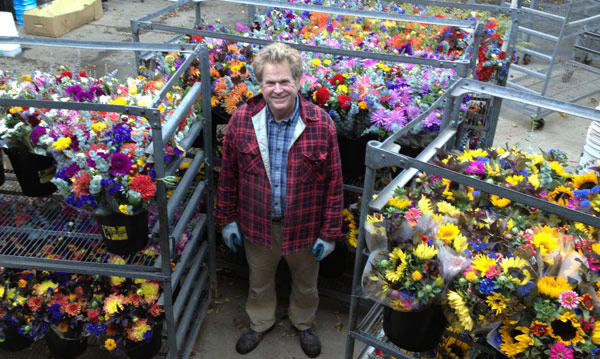
Grow something out of the ordinary, of unmatched quality, in ample quantity. Photo: Charles Little & Co.
The recipe for a successful crop mix is as varied as flower farms themselves. Key considerations include the amount of acreage you have available to you as well as what you like to grow.
Charles and Bethany Little are veteran growers and certifiable plant lovers. They write this on their website's "about" page: "Top florists and wholesalers are forever hungry for something unique, something they have never seen. It's our job to provide these kinds of flowers in both quantity and unmatched quality."
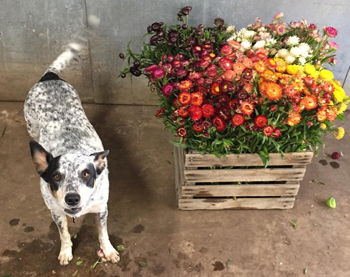
Remy & the Everlastings. Grow what you can accommodate, grow what you love. Photo: Charles Little & Co.
When Charles began the farm in 1986, he originally grew "everlasting" flowers for the craft market. Later, with changing customer preferences, he and Bethany transitioned to herbaceous and woody crops, although they did not abandon the annuals that dry well.
"I still love the things that give you two or three opportunities to harvest," Charles says. "Whether it's the flower in the spring or the pod in the fall, it's always great to have some kind of backup plan for a flower. Certainly, we grow statice, ammobium, and strawflower… all are great dried flowers, but they're almost better as cut flowers."
Charles is always on the lookout for something new and unusual to satisfy customer demand. "It's so important for growers to ignore what the competition is growing and study the seed catalogs, read the trade journals, wander around garden centers and nurseries and even through people's yards. That's the way to find things that no one else is growing."
When to Harvest
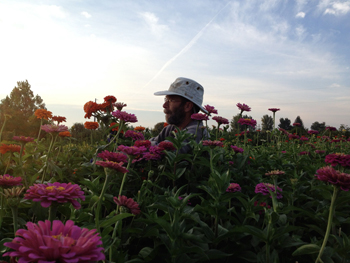
Harvest when heat and wind are at their nadir — especially in hot, dry climates. Photo: Deadhead Cut Flowers.
In Blackfoot, Idaho, Ralph Thurston and Jeriann Sabin are transitioning from owning and operating Bindweed Flower Farm to writing and teaching through their new business, Deadhead Cut Flowers. That's also the name of Ralph and Jeriann's first book, which is filled with the kind of lessons you only learn after flower farming for nearly three decades (Ralph has just issued a second book titled All Pollen, No Petal: Behind the Flower Farming Dream).
Ralph and Jeriann have a lot to share about flower-farming best practices. The day I spoke with them by phone, Ralph confessed that while supposedly "retired," he still wakes at 4am to help Bindweed's new owner, nephew Ben Josephson. "We harvest every day, and some flowers must be checked and harvested several times a day," he says. "If flowers are harvested at their peak time and properly conditioned, they will hold better for both the farmer and for the client."
That means harvesting early in the morning, before the heat of the day causes flowers to lose moisture and begin to dehydrate. "This is especially crucial in hot, dry climates like ours," Jeriann explains. "It really needs to be cool, so that means before sunup, with a headlamp. If you harvest early when that plant is still vigorous, you're getting a better product."
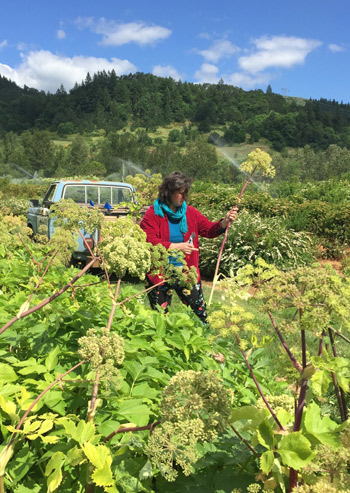
Observe and experiment with what's best for your own particular zone/microclimate. Photo: Charles Little & Co.
While the climate of South Carolina's Low Country differs markedly from the high desert of Idaho, hydration is equally important on her farm, says Laura Mewbourn. "Our summer heat is brutal, so flowers get harvested as early or as late as possible — then popped straight into the cooler. My flowers are never out of water. I'm mindful about making sure my buckets are clean, and I use alcohol wipes on my clippers when necessary. Overall, I think it's most important to develop a researched and consistent practice in harvesting."
Charles Little & Co. employs a small crew to harvest their flowers. While doing so early in the morning is important, Charles will often start the crew's day with weeding for a few hours before harvesting.
"Typically, crops are soaking wet at daybreak, but once the sun is out and the wind has picked up, the flowers start to dry off. So, a typical process is for us to weed from 6 to 8:30am, then switch to harvesting until 1 or 2pm," he explains. Sometimes it's raining: "Everything's wet, so before we can put that product in the cooler, we have to clean the stems and lay it loose on a cart and run our fans," he explains.
The differences between harvesting practices in Western Oregon, where there are dewy mornings and Blackfoot, Idaho, where flowers rarely experience dew illustrate how site-specific each farm can be — and consequently how important it is to observe and experiment with what's best for your own particular zone/microclimate.
Bucket Care
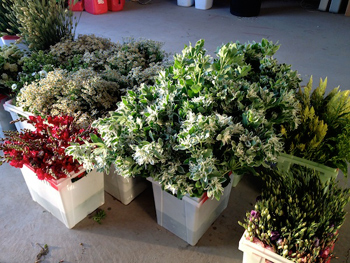
Harvest flowers at their peak readiness, with speed and clean tools, water, and buckets. Photo: Deadhead Cut Flowers
It almost goes without saying: Harvesting into clean buckets equals a superior botanical product.
"Post-harvest practices take time to get a handle on," says Janis Harris. "I think the water source is very important. We are blessed with a very deep, very clean well. Everything on our farm is harvested and immediately placed into a bucket of clean, cold water."
Jeriann Sabin and Ralph Thurston maintain that it may not be necessary to haul buckets of water out to the fields for harvesting. "There is no need if you are harvesting at the proper time of day, if it is cool and the flower is completely hydrated during the night (so it is full of moisture and nutrients). Ralph is lightning fast — Samurai fast," Jeriann jokes. "There is a ticking time bomb in his head — he cuts all that he can for 10 minutes and gets that up to the barn and into water; then he heads out for more."
And while they hear about flower farmers who invest in costly "bucket-washing stations," Ralph and Jeriann are big believers in simple tools and elbow grease. "We have a hose and a corral brush," Jeriann says. "We do not let buckets sit more than one week before washing them out. You just have to do the work, especially so you're delivering flowers in clean buckets, with freshly conditioned water and fresh cuts on the flower stems."
| Jeriann & Ralph's Bucket-Washing Formula | ||||||
|---|---|---|---|---|---|---|
| For each bucket, use: 1 GALLON WATER + 1 GOOD SQUIRT DISHWASHING LIQUID + 1 "BIG GLUG" BLEACH | ||||||
| Step 1 | Step 2 | Step 3 — For Really Scary Buckets | ||||
|
|
|
||||
Holding, Storing, Refrigeration
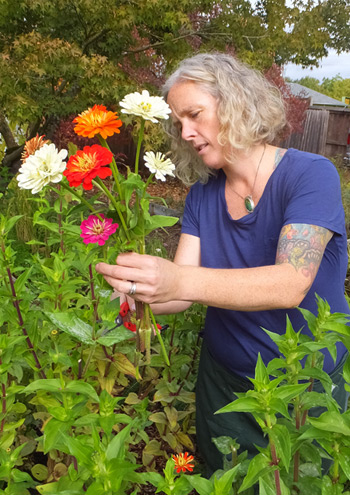
Adding refrigeration in her 3rd year of flower farming was a game-changer for Melissa Garcia Parry of Howl & Whistle Flower Farm. Photo: Howl & Whistle Flower Farm.
Flower farmers agree that refrigeration is essential. Even though she actively grows on about ⅛-acre in her urban neighborhood, Melissa Garcia Parry of Howl and Whistle says that adding refrigeration in her third year of flower farming was a game-changer for productivity, efficiency, and profitability.
Rather than investing in a walk-in cooler or CoolBot system, Melissa converted two chest-style freezers with an adaptor that controls temperatures, keeping them at just below 40°F (4.4°C). "They have revolutionized my life," she maintains. "I've now been able to harvest on Thursday and hold things for a few days, before going to the Saturday Market. I'm just one person and I do cut into water, but now I can harvest and bring my flowers into the 'Kegerator,' which is what the system is called."
After growing flowers for a decade, Janis Harris insists that "100%, a cooler is a must! We can pick flowers all week and either hold them until the weekend or use them during the week. Because my flowers are in a cooler, I feel less urgency to unload them; I can sell them when I want to."
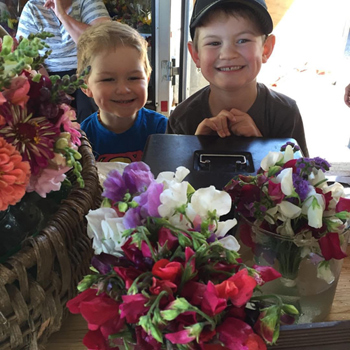
Janis of Harris Flower Farm is experimenting with flower-food recipes for the first time this season. Although her flowers have done well in the past without it, "We'd like to see if it improves the life of our flowers," she says. Photo: Harris Flower Farm
Janis says she's experimenting for the first time with various flower-food recipes this season. "Our flowers have always done very well in the past, so we didn't use flower food. But we'd like to see if it improves the life of our flowers. I also use a half-cap of chlorine bleach in zinnia and sunflower buckets."
Charles Little agrees that his farm's 12x24-foot walk-in cooler is an essential flower-farming tool. "It's so typical for our crew to come in from the fields at 2pm, and despite all the effort we made to get those flowers cut and into water quickly, placed in the shade or in the truck under the canopy, those flowers look wilted. It requires confidence to know that after getting them into the cooler, they're going to perk up and everything will be fine by the next morning." Charles and Bethany do not use floral preservative or flower food. "For things we think need a little extra something, we might add a chlorine pill. For the woodies, we like to use Quick Dip."
Selling to Florists
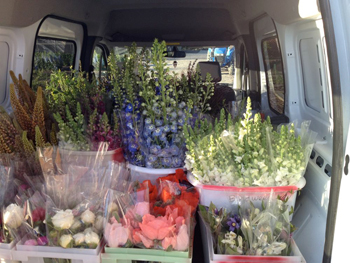
"Visually," notes Jeriann of Deadhead Cut Flowers, "everything on my truck looks alive and fresh; the flowers are deeper and richer in color; the petals often have better texture…" And then, there is fragrance: "When I open my truck doors, I can smell the flowers." Photo: Deadhead Cut Flowers
Ralph and Jeriann built Bindweed Flower Farm selling their flowers direct to florists in Sun Valley, Idaho and Jackson Hole, Wyoming — markets located over 2 hours away from their farm. "We don't have refrigerated trucks, but our flowers come right out of the cooler and into a cool truck," Jeriann says. "And I do run the A/C while driving our deliveries."
As a result of proper harvesting and processing, the flowers arrive in excellent condition, she says. "I am constantly observing and gathering details on what my clients are using, what's coming in from large wholesale entities, so I can often do a side-by-side comparison. Visually, everything on my truck looks alive and fresh; the flowers are deeper and richer in color; the petals often have better texture. Even overnight boxes from good companies cannot compare — they look dehydrated because they are. When I open my truck doors, I can smell the flowers. Each one has been harvested properly at its peak harvest moment. I always feel comfortable guaranteeing our flowers for a week to 10 days, if handled correctly. But I make it a policy to know my clients and often, what they are using the flowers for. Their reputation (and ours) is riding on our product.
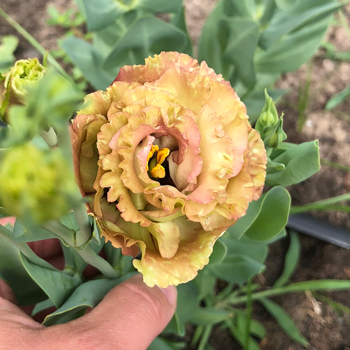
Laura Mewbourn of Feast & Flora Farm believes in delivering exceptional value. She will do some or all of the processing normally required by her designer client before she delivers their flowers, and will also add a few extra stems. Photo: Feast & Flora Farm
Laura Mewbourn, of Feast and Flora, knows what's it like to receive poor quality flowers from a supplier for her design work. "From a designer's perspective, receiving a bunch of flowers with several unusable stems — or worse, an entire bunch that shatters — is heartbreaking, and often results in a last-minute scramble to find replacements. I don't want that to happen to my clients with my flowers, so I do some or all the processing that is normally done by the designer after receiving shipped flowers. I want the designer to have to do less when she or he receives my product."
Laura also adds a few extra stems before delivering to florists. "I've certainly never received an extra stem from the (conventional) wholesaler, but it is worth the extra small amount of money on my part to ensure that my clients are getting what they paid for."
Selling at Farmers' Markets
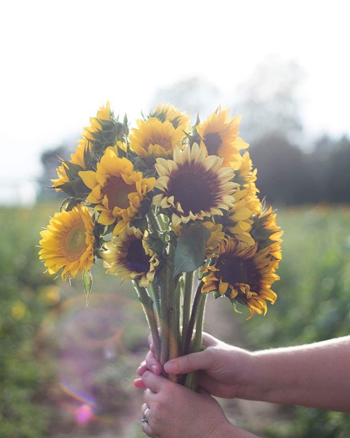
Customers appreciate learning about the flowers they purchase: "We tell [them] about the harvesting stage (petals just lifting compared to blown wide open) and variety selection (pollenless, strong petals/stems, cutting varieties), so they know why ours are superior," says Janis Harris of Harris Flower Farm in Ontario, Canada. Photo: Harris Flower Farm
Consistency and constant communication with customers are among Harris Flower Farm's best marketing strategies, Janis says. "Our customers are accustomed to receiving high quality flowers from us. We've built our business over the past 10 years, and people know what to expect. Our flowers may run at a higher price-point than our competitors', but we continue to add new and better flower varieties to our lineup that others don't grow. There may be another vendor at our market who is selling sunflowers for much less than we are. We tell the customer about the harvesting stage (petals just lifting compared to blown wide open) and variety selection (pollenless, strong petals/stems, cutting varieties), so they know why ours are superior. Often the customer will come back on another market day to thank us for educating them, and tell us how much they enjoyed their flowers."
Keeping flowers fresh at the farmers' market is a constant challenge, Janis continues. "When we are selling at a market, the bouquets are always kept in a shady spot, such as under a canopy or tent — never in direct sun."
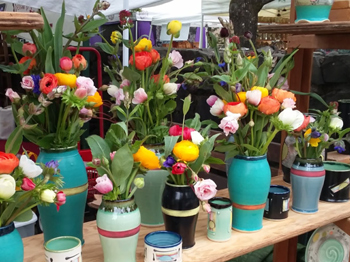
Melissa, of Howl & Whistle says, "I like to help people understand that I'm the person who grew this flower. It's hyper-local, from 2 miles away." Photo: Howl & Whistle Flower Farm
Laura Mewbourn says, "I know some farmers put frozen water bottles in their flower buckets to keep them cool at market. Others have rigged up curtains, sometimes even made from the shade cloth we use in the field, to block wind and light."
Melissa, of Howl and Whistle, shares a covered stall with her husband Dave Parry, a potter and owner of Whistle Post Pottery, at the all-day Saturday Market in Eugene. They often switch sides during the day, following the shade (for flowers) and the sun (for pottery).
"I like to help people understand that I'm the person who grew this flower. It's hyper-local, from 2 miles away. I end up recognizing repeat customers and having conversations about my flowers and my growing practices," she says. Recently, when a shopper mentioned trying to decide between buying Howl and Whistle's flowers or picking up flowers at Trader Joe's, Dave was quick to ask, "Do you want to support someone who farms a couple of miles away, or a large corporation whose flowers come from who knows where?" The customer "bought two bouquets and went away happy," Melissa adds. "I realized that I've assumed people make supporting locally-grown flowers a priority, forgetting that the layperson may not even think about that. It's a reminder to have conversations, keeping it light and educational, and say, 'Hey, I grew all of these flowers.' "
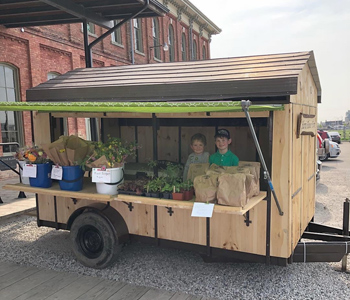
For Janis of Harris Flower Farm, keeping flowers in the shade is essential. Her dad recently built her this mobile cart with a canopy. Photo: Harris Flower Farm
"I absolutely talk with my farmers' market and retail customers, about how to ensure their flowers last as long as possible," Laura says. "I also advise them on the vase life of individual varieties. Customers are wowed by dahlias, for instance, but don't necessarily know why they don't last as long as a zinnia. I hope I'm teaching my retail customers to appreciate a wider range of flowers and to understand that even after they're cut they are a living thing that needs to be treated well to remain lovely as long as possible."
For Janis, keeping flowers in the shade is essential. "The deciding factor when we are presented with a new market is whether there is some type of covering. This past winter, my dad built a mobile flower cart from an old livestock trailer for us, fashioning it with a good canopy cover to shade the flowers. We use it for transporting and displaying flowers at markets and events."
for market customers
- Make a fresh cut in each stem.
- Strip off any foliage that will lie below the water line.
- Keep your vase as clean as you would your wine glass or tea cup!
- Make sure your bouquet sits out of direct sunlight & drafts.
- Replenish water every day or two.
She sends farmers' market buyers home with bouquets wrapped in a small baggie filled with water for the trip home. "Then, in conversation, we say, 'Make sure to change the water every couple of days. Flowers like clean, cool water, so don't display them in a window where the sun will heat up that water.' "
Back when they sold at farmers' markets, Ralph and Jeriann stapled a 'care guide' to their flowers. "It recommended making a fresh cut; stripping off foliage that's under water; keeping vases as clean as you would your wine glass or tea cup; and making sure your bouquet sits out of direct sunlight," Jeriann says.
The Good, the Bad & the Best-Sellers
I asked all the farmers to name some of their favorite and not-so-favorite flowers. You may be surprised by what they shared!
Crops you love to grow because they hold up well
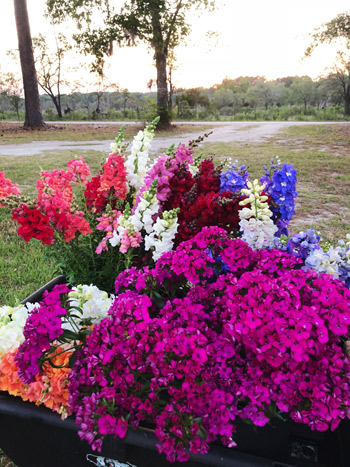
"My 'Amazon Neon Purple' dianthus has an amazing vase life," notes Laura of Feast & Flora. "[T]he 'Chantilly' and 'Madame Butterfly' Series snapdragons are popular with my design clients and florists alike, and after one week, they are still holding their color so well." Photo: Feast & Flora Farm.
- Jeriann & Ralph: Sunflowers, tulips, asclepias, bells of Ireland, phlox, sage, raspberry and blackberry foliage, viburnum, and delphinium.
- Melissa: The 'Chief' Series of celosia. "It stops people in their tracks and they want to know what it is — which allows me to have a conversation," she says. "It doesn't wilt or droop, and I was able to dry anything that didn't sell and make it into velvety Christmas wreaths. I feel like a genius getting a second product out of it! I also love zinnia 'Queen Red Lime' and others in the series. They are serious workhorses and they get so much attention from customers." Scabiosa and strawflowers are two other favorites. "Their novelty at market is a reward for the sweaty days of harvesting."
- Janis: Lisianthus. "We love it for wedding work, and customers love it because it has such a long vase life."
- Laura: "I love to grow zinnias, particularly the 'Benary's Giant' Series for their amazing vase life. It's not unusual for a client to report their bouquet still looks beautiful after a week or 10 days. I have a growing collection of heirloom chrysanthemums — their staying power is positively bionic, and their unique colors are appreciated by even the most avid mum hater. My 'Amazon Neon Purple' dianthus has an amazing vase life — 10 days or more — so it's gotten a lot of play in my arrangements. It's also hard to go wrong with any of the snapdragons — the 'Chantilly' Series and 'Madame Butterfly' Series are popular with my design clients and florists alike, and after one week, they are still holding their color so well."
- Charles: "I love to grow crops that you can just 'rake' when harvesting. Like lavender — you can just grab it and hack away at it. I also love the direct-sown varieties, such as foxtail grass, millet, sunflower, zinnia, safflower."
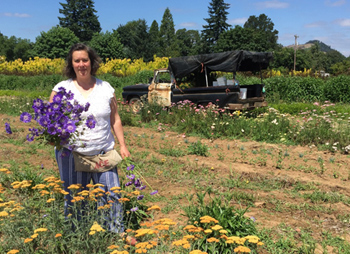
The tedium of harvesting scabiosa can be minimized, find Charles & Bethany Little, by lining stems up at their bases rather than their heads, then sorting them post harvest. Setting a higher price point for them will cover any extra time they may require in handling. Photo: Charles Little & Co.
Crops you love less, because they're fussy (but important to your customers)
- Jeriann & Ralph: Clematis, because it needs to be netted and is time-consuming to harvest because of intertwining vines.
- Melissa: "Last year, I felt like every single aster was triple the work. I don't know if they're extra needy or if I'm just bad at growing them, so I've simply taken them out of my rotation this year."
- Janis: "I wouldn't say I hate zinnias, but they can be frustrating. They don't like the cold temperatures of the cooler, but warmth makes the water go funky. Zinnia meltdown disease seems to be a common problem. It's a flower that has to be picked and sold quickly, too. It takes some practice to teach or understand the 'wiggle test': When I am picking the flower, I give the stem a quick jiggle to see if the flower wobbles. If it wobbles, it isn't ready. If it's strong, it's ready to pick."
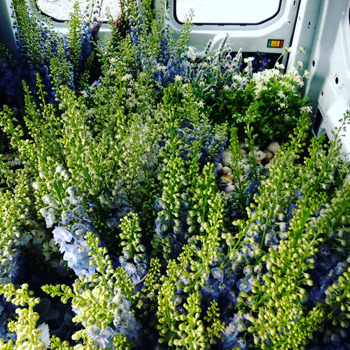
"The key is quality," notes Jeriann of Deadhead Cut Flowers, "and driving home the superior quality of your product." Photo: Deadhead Cut Flowers
- Laura: "My love-hate flowers are probably the same as most designers: poppies and dahlias, both of which are so beautiful and so finicky. I'll never stop growing and using them, but I don't include them in my weekly subscriptions. I save them specifically for special occasions and events."
- Charles: Scabiosa. "They're tedious to harvest, so it's a complicated crop. But it's so popular and easy to sell. We have raised our price on it, and customers still buy it. When harvesting, instead of lining up the heads (to have a uniform bunch of stems), we line up the base of the stem to make the bunch. It's irregular; short stems are mixed with tall stems, but it gets cut, put in water and into the cooler. Later, as we process for orders, we sort and grade by stem lengths."
After spending time with each of these inspiring flower farms, the best advice I heard can be distilled into "Find what works for you. Then keep experimenting and improving."
"The key is quality," says Jeriann. "And, driving home the superior quality of your product."
"My florists absolutely recognize a higher-quality product when they see it because they see product of all levels all day long," Laura points out. "When I hear squeals as I bring in my buckets of flowers, I know I'm doing my job well. My retail customers notice that my flowers tend to last longer than what they can get from a grocery store and appreciate receiving good value from their purchase."
Learn More
- 5 Factors That Determine the Vase Life of Cut Flowers • Article
- Postharvest Handling of Cut Flowers and Greens: A Practical Guide for Commercial Growers, Wholesalers, and Retailers. John Dole, NC State University; Robert Stamps, University of FL; Alicain Carlson, NC State University; Iftikhar Ahmad, NC State University & University of Agriculture, Faisalabad; Lane Greer, OK State University; Judy Laushman, Editor. Published by ASCFG • 360-pp Book
- Postharvest Disease of Zinnia: A New Threat to Cut Flower Production, by Fulya Baysal–Gurel, PhD, Tennessee State University. Cut Flower Quarterly, 33 (2), 22–25.
- The Procona System: Economical, recyclable, lightweight. An all-in-one system for harvesting, postharvest handling, transporting, and marketing cut flowers and foliage • 4-pp Brochure


